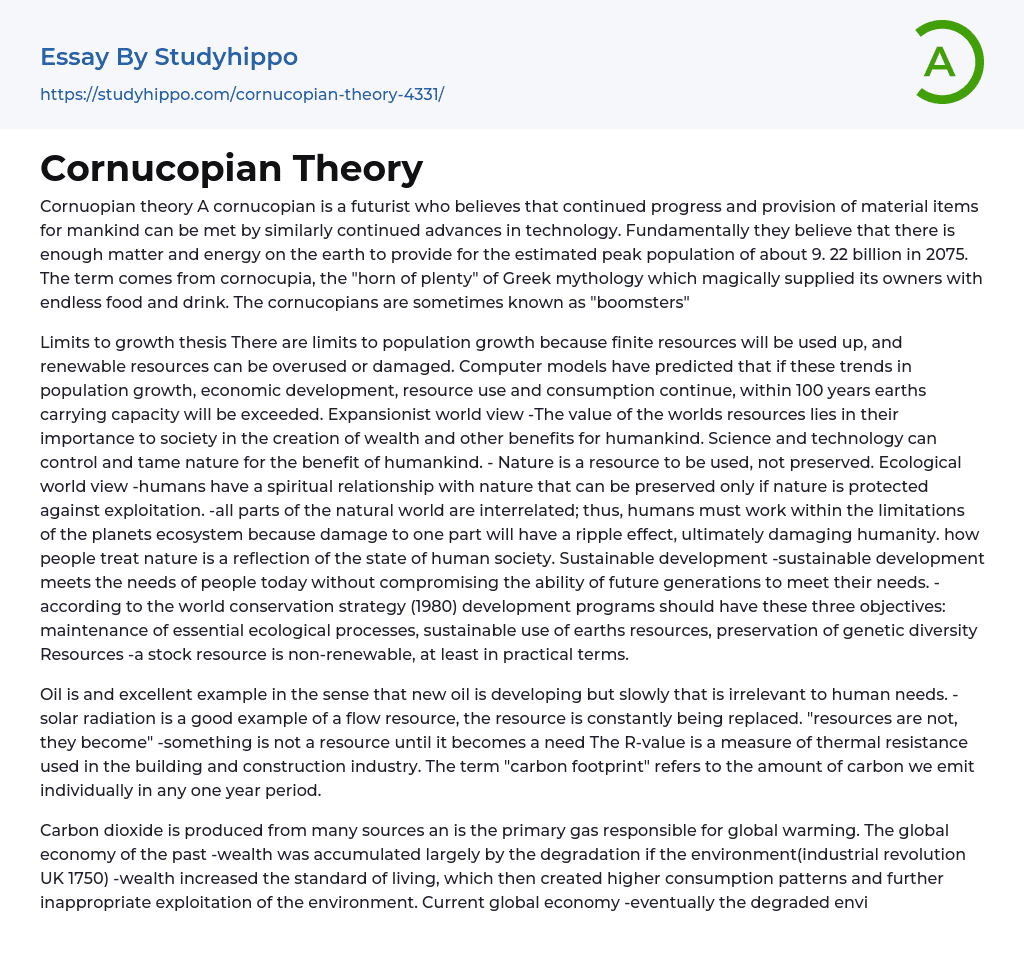Cornuopian theory A cornucopian is a futurist who believes that continued progress and provision of material items for mankind can be met by similarly continued advances in technology. Fundamentally they believe that there is enough matter and energy on the earth to provide for the estimated peak population of about 9. 22 billion in 2075. The term comes from cornocupia, the "horn of plenty" of Greek mythology which magically supplied its owners with endless food and drink. The cornucopians are sometimes known as "boomsters"
Limits to growth thesis There are limits to population growth because finite resources will be used up, and renewable resources can be overused or damaged. Computer models have predicted that if these trends in population growth, economic development, resource use and consumption continue, within 100 years earths carrying capacity will be exceeded. Expans
...ionist world view -The value of the worlds resources lies in their importance to society in the creation of wealth and other benefits for humankind. Science and technology can control and tame nature for the benefit of humankind. - Nature is a resource to be used, not preserved. Ecological world view -humans have a spiritual relationship with nature that can be preserved only if nature is protected against exploitation. -all parts of the natural world are interrelated; thus, humans must work within the limitations of the planets ecosystem because damage to one part will have a ripple effect, ultimately damaging humanity. how people treat nature is a reflection of the state of human society. Sustainable development -sustainable development meets the needs of people today without compromising the ability of future generations to meet their needs. -according to the world conservation
strategy (1980) development programs should have these three objectives: maintenance of essential ecological processes, sustainable use of earths resources, preservation of genetic diversity Resources -a stock resource is non-renewable, at least in practical terms.
Oil is and excellent example in the sense that new oil is developing but slowly that is irrelevant to human needs. -solar radiation is a good example of a flow resource, the resource is constantly being replaced. "resources are not, they become" -something is not a resource until it becomes a need The R-value is a measure of thermal resistance used in the building and construction industry. The term "carbon footprint" refers to the amount of carbon we emit individually in any one year period.
Carbon dioxide is produced from many sources an is the primary gas responsible for global warming. The global economy of the past -wealth was accumulated largely by the degradation if the environment(industrial revolution UK 1750) -wealth increased the standard of living, which then created higher consumption patterns and further inappropriate exploitation of the environment. Current global economy -eventually the degraded environment created in causes less wealth to be created, which in turn increases stress on society. in an attempt to generate more wealth, further environmental degradation occurs; a negative feedback loop is created in which the environment continues to be degraded. -at some point there is a relocation that our parasitic relationship with the environment is destroying four home. The periphery - the periphery consists of the countries in the rest of the world: Africa, south America, Asia and Russia and many of its neighbors (not Japan and south Korea). Although some parts of this area exhibits positive
development, it is generally characterized by extreme poverty and a low standard of living.
Health care is non existent in many places, there is less access to potable water than in industrialized core, and poor infrastructure engenders slum conditions. Population is skyrocketing in the periphery because of a number of contributing factors including a limited ability to move and the use of children as means to support a family. The core in geography The core consists of Europe (excluding Russia, Ukraine and Belarus) the united states, Canada, Australia, new Zealand, Japan, south Korea, and Israel.
Within this region is where most of the positive characteristics of globalization typically occur; transnational links, modern development )higher wages, access to health care) scientific innovation, and increasing economic prosperity. These countries also tend to be highly industrialized and have a rapidly-growing service (tertiary) sector. New core- receive the most benefits of globalization Old core- experienced both benefits and hardship of globalization. Far periphery- hopeful, waiting on more benefits of globalization.
- Anthropology essays
- Audience essays
- Charity essays
- Cultural Competence essays
- Emile Durkheim essays
- Gender Roles essays
- Generation essays
- Globalization essays
- Interpersonal Relationship essays
- People essays
- Race essays
- Social Change essays
- Social Class essays
- Social Movement essays
- Social Science essays
- Social Status essays
- Social Stratification essays
- Society essays
- Sociological Imagination essays
- Sociological Perspective essays
- Sociological Theories essays
- Stereotypes essays
- Web Dubois essays
- Atmosphere essays
- Biodiversity essays
- Coral Reef essays
- Desert essays
- Earth essays
- Ecosystem essays
- Forest essays
- Lake essays
- Natural Environment essays
- Ocean essays
- Oxygen essays
- Rainbow essays
- Sea essays
- Soil essays
- Volcano essays
- Water essays
- Wind essays
- Experiment essays
- Explorer essays
- Hypothesis essays
- Observation essays
- Qualitative Research essays
- Research Methods essays
- Theory essays




